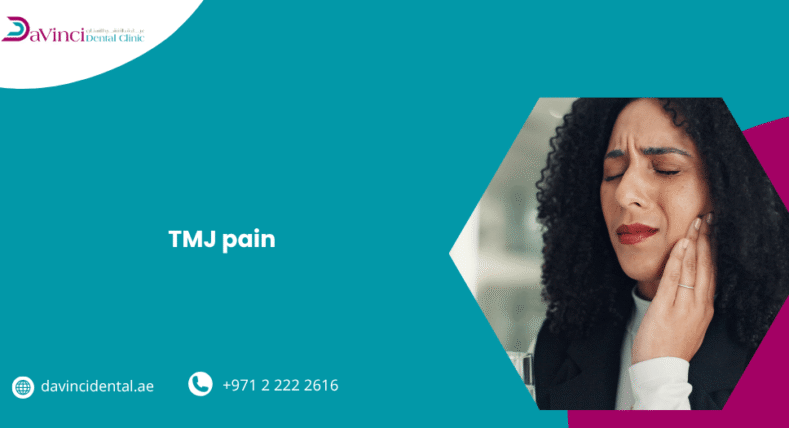You may be suffering from a temporomandibular joint dysfunction (TMD) if you have headaches, chronic jaw discomfort, or trouble speaking and chewing. These disorders cause pain and restricted functionality by affecting the joints and muscles that control jaw movement.
The first step in receiving the proper diagnosis and care is speaking with an experienced TMJ specialist in Abu Dhabi.
In this article, we will guide you through everything you need to know about TMJ disorders, including how they are identified, treated, and why consulting a reliable professional is essential for long-lasting relief.
Table of Contents
What Is TMJ?
The joint that connects your jaw to your skull is called the temporomandibular joint (TMJ). A TMJ is located in front of each ear on each side of your face.
The motion of the joints is complicated. These joints move when you talk, swallow, eat, and make facial expressions.
What Is TMD?
Temporomandibular disorders (TMDs) are a collection of over 30 conditions that cause discomfort and dysfunction in the jaw joint and the muscles that regulate jaw movement.
“TMJ” exclusively refers to the temporomandibular joint; “TMDs” refers to the diseases. TMJ dysfunction occurs when there are:
- Issues with the jaw joint itself.
- Issues with the muscles in your face around the TMJ.
- A mix of joint and muscle issues.
- Problems with the jaw joint are very common.
How Is TMD Diagnosed?
TMJ disorder can be identified by medical professionals during a physical examination or dental examination. The doctors can notice the range of motion when you open and close your mouth.
To identify trouble spots, they might apply pressure to your jaw and cheek.
As you open and close your mouth, they can feel the area surrounding your jaw joints.
In order to examine your jaw joints and surrounding tissues more closely, they could also do imaging studies. These imaging examinations could consist of:
- Dental X-rays.
- Computed tomography, or CT, scans.
- Magnetic resonance imaging, or MRI.
- TMJ arthroscopy (used for diagnosis and, in some cases, treatment).
What To Expect If You Have TMJ Disorder?
The effects of TMJ dysfunction vary from person to another. For some, it’s a short-term problem that disappears within a week or two. Others have a chronic illness that lowers their quality of life.
Inform your doctor if you frequently have headaches, face pain, jaw pain, or other TMJ symptoms. They can assist you in locating a successful course of treatment.
In certain cases, TMD resolves on its own within a week or two. However, in extreme cases, it may last for months or even years. Both acute and chronic TMJ disorders are possible.
How To Prepare For TMJ Disorder Treatment?
To determine what kind of treatment is best for the patient, a thorough examination will be conducted first. The procedure will proceed based on the type of treatment that will be used.
The dentists will take X-rays, three-dimensional scans, and pictures. Various techniques will be applied based on the images to create the ideal plan.
The computer will be used to provide an idea of the tooth condition. Both the patient and the doctor are spared difficulties during the treatment due to the detailed consultation that takes place.
What Does The Procedure Include?
The patient will first get a local anesthetic injection. After that, the patient will receive treatment from the doctor using a tube or cannula that is placed into the jaw by making a skin incision.
The doctors will mark the region to be treated, and the patient will then get treatment. The jaw will be reshaped using various tools, including titanium ones.
The doctor will dissolve the blood with a cotton pad throughout the procedure. Equipment will position the jaw correctly, and once the skin has been properly adjusted, it will be cleansed and sewn. In a month and a half, the pain will fade.
The Procedure Aftercare
For a few days, you will be advised by the dentist to follow a liquid diet, maintain a clean mouth, and carefully wash your jaws. To lessen the swelling brought on by the procedure, apply cold packs, and for a while, use raised pillows.
You could be advised to take certain medications in order to get better right away. After the treatment, the surgeon will explain to the patient the necessary precautions and post-treatment care.
The Best TMJ Specialist In Abu Dhabi
You can find the best TMJ specialist in Abu Dhabi at Davinci Dental Clinic. Our doctors will do the necessary examinations and checks to determine the root cause of the issue and administer the correct treatment.
If you suffer from the consistent pain of TMJ disorders, contact us to relieve your pain.
Read More: TMJ Treatment In Abu Dhabi.
Conclusion
It can be difficult to live with TMJ issues, which can affect your general quality of life and everyday comfort.
Effective treatments are available to relieve your pain and restore normal jaw function, especially if you receive the proper care from a qualified TMJ specialist in Abu Dhabi.
Our skilled staff at Davinci Dental Clinic offers detailed examinations and individualized treatment programs based on your situation.
Make an appointment for a consultation to start down the path to a pain-free future and stop letting TMJ discomfort rule your life.
Read More: TMJ Disorder In Abu Dhabi.
Frequently Asked Questions
Which specialist doctor to consult for TMJ?
Working with a dentist or oral and maxillofacial surgeon is essential for figuring out the best course of action for your particular TMJ condition. The dentist will help you manage the symptoms to make it possible to control TMJ symptoms and enhance general jaw health with the right care.
What is the newest treatment for TMJ?
One of the newest and most promising treatments for TMJ/TMD is Botox injections. Although Botox is frequently linked to cosmetic operations, it has demonstrated impressive outcomes in reducing TMJ/TMD-related muscle tension and jaw discomfort.
What is the 3-finger test for TMJ?
A simple yet efficient technique for evaluating jaw function and mobility is the three-finger test for TMJ. To find out if their jaw opens wide enough without causing pain, people can place three fingers vertically between their upper and lower teeth.




